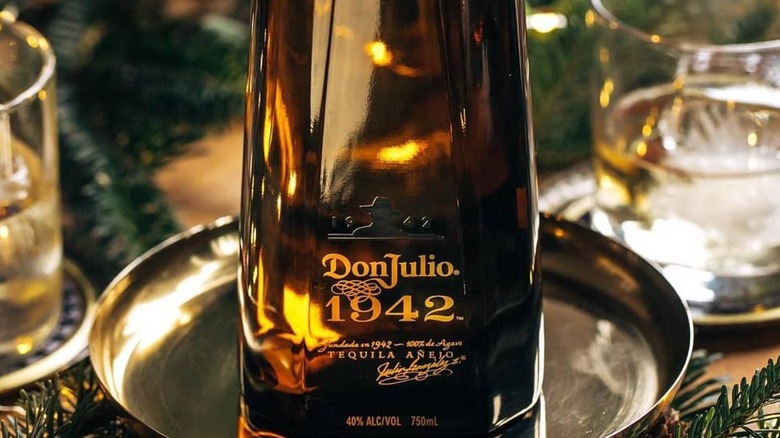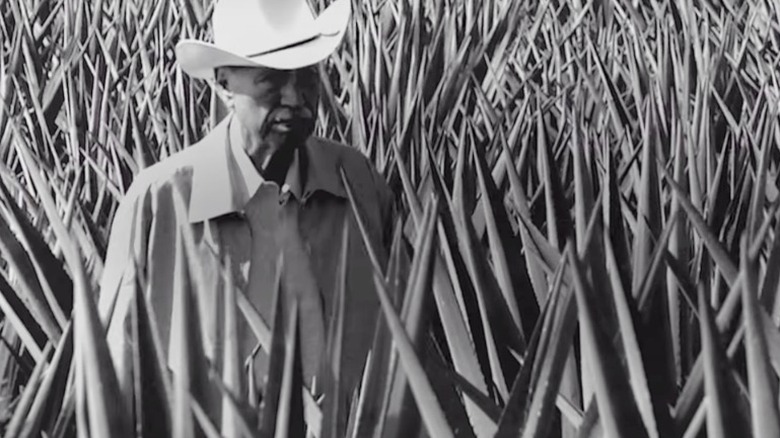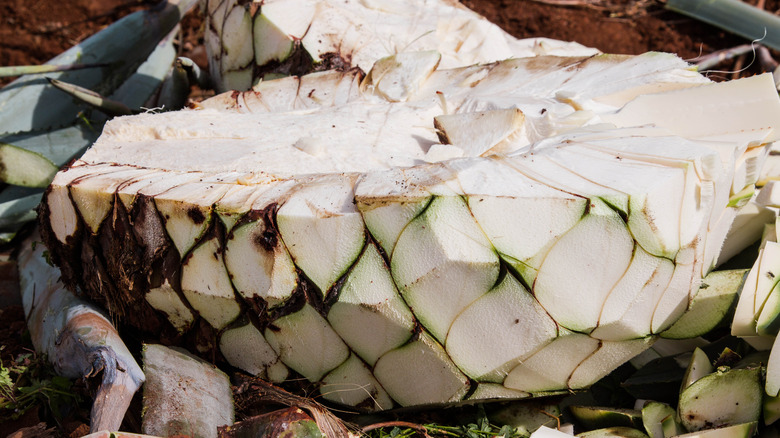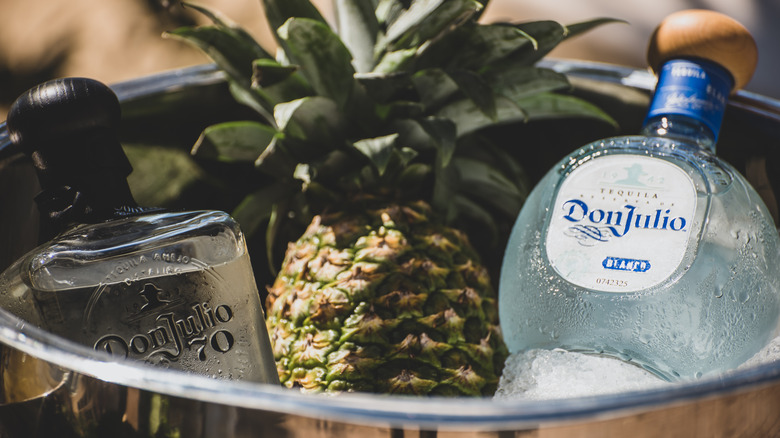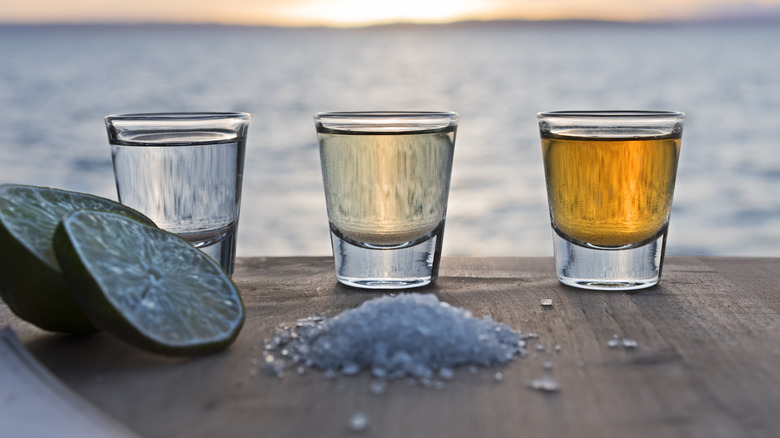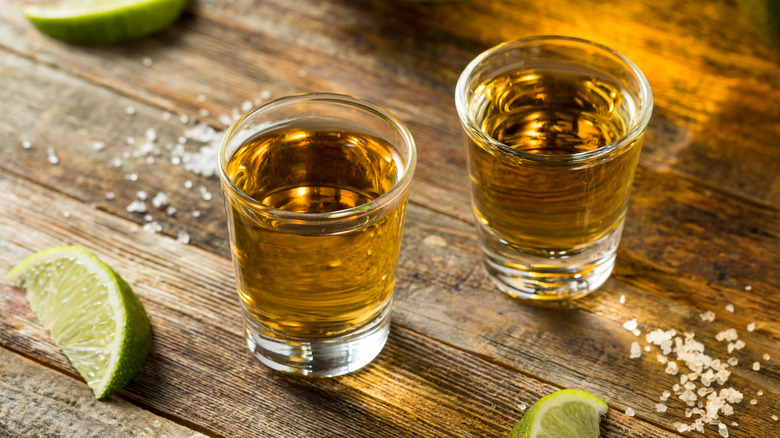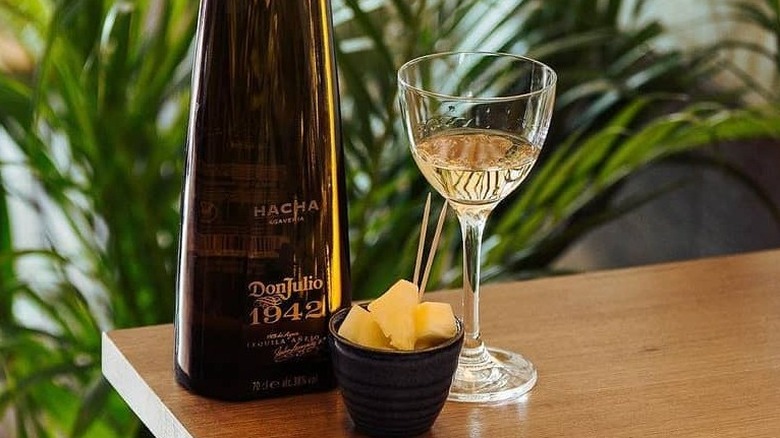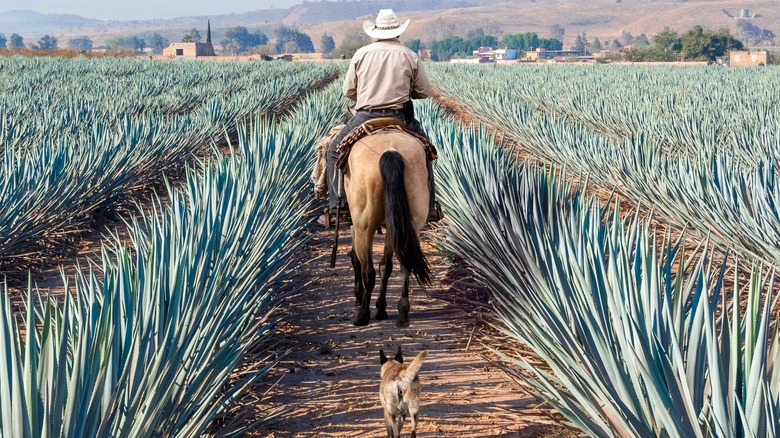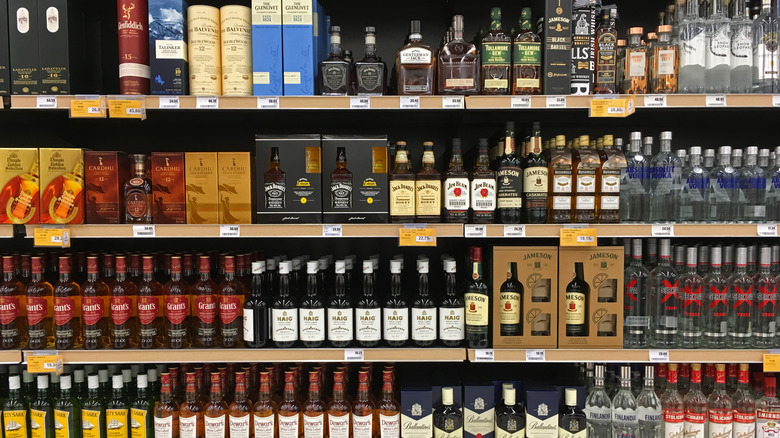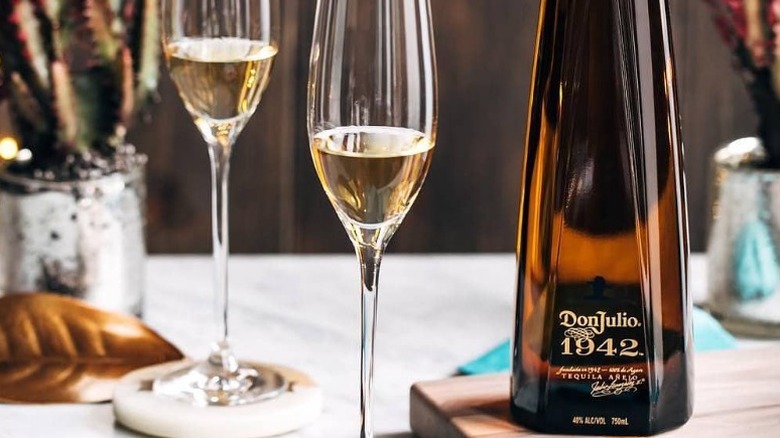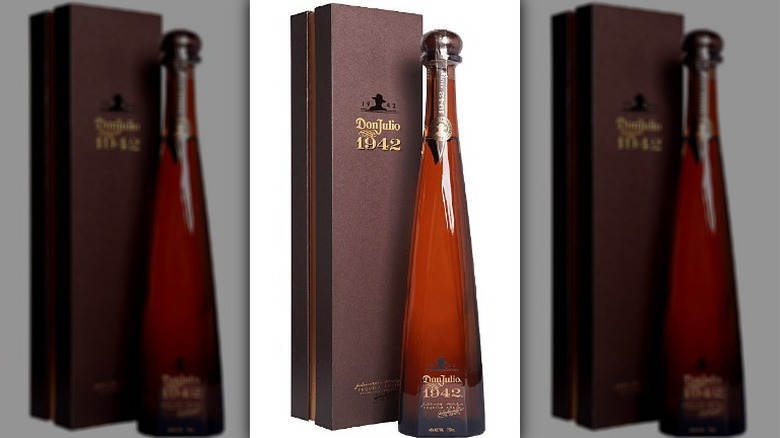Don Julio 1942 Tequila: The Ultimate Bottle Guide
There are few brands that feel more synonymous with "luxury tequila" than Don Julio. In fact, Don Julio González himself created the category that, according to Forbes, has become the fast-growing of any in the U.S. spirits industry in recent years: ultra-premium tequila — especially as more celebrities seek to enter the industry themselves (think: George Clooney's Casamigos and Kendall Jenner's 818 Tequila).
However, there is hardly a bottle more famous than the sleek, elegant Don Julio 1942. But what makes this bottle so special? And what even is tequila añejo — a caramel-colored variety that looks far different from the clear tequila we most often see in popular cocktails like margaritas and palomas?
In this article we will cover the history of Don Julio, how añejo tequila is made (and why it dominates the highest price points of tequila), and what makes Don Julio 1942 a standout bottle among the other competitors. We'll also discuss the average price point of Don Julio 1942, where to find it, how to store it, and the best ways to serve up this highly lauded liquor at home.
The origin and history of Don Julio, the man
The prestige of Don Julio 1942 begins with the man himself. While the origins of the ever-popular tequila brand may sound more like folklore than reality, there actually was a Don Julio, and he began what would one day become one of the most iconic liquor brands at the ripe age of 17.
Don Julio González was born in 1925 in the Jalisco Highlands — the largest tequila-producing region today — and was forced to become the breadwinner for his family as a teenager upon his father's death. González soon realized that working as a farmhand wasn't going to pay enough to support his mother and six siblings, and he took a leap of faith by starting his own business: selling tequila around the Jalisco Highlands on horseback.
After two years of selling tequila, Don Julio made the game-changing decision to ask a wealthy merchant who was considered a local celebrity for a loan to build and operate his own distillery in 1942 (via Diageo Bar Academy). The man was so impressed by Don Julio's pluck and determination, that he became his first investor. The distillery was named La Primavera — which also happens to be the name of the latest special-edition bottle of Don Julio Tequila in its honor — and Don Julio began pioneering the tequila industry under his original Tres Magueyes label.
The pioneering ideas of Don Julio
What made Don Julio González's tequila such an icon was that González was dedicated to pursuing quality over quantity even though it required more time, effort, and money. Don Julio began planting agave farther apart to give the plants more room to flourish, and he didn't harvest the plants until they were fully mature. These methods of growing and harvesting have become key standards for tequila producers since.
Don Julio also only selected the ripest, juiciest parts of the piñas, or agave hearts, and slow-roasted them for three days to achieve perfect caramelization and to bring out a depth and complexity of flavor that his competitors didn't have. This production process set a new benchmark for tequila and established the first-ever "luxury" tequila option: one that was ultra-smooth, full of flavor, and incredibly nuanced.
González also pioneered today's tequila bottles, as they were traditionally tall enough to store on the floor underneath a table. He aspired to create a vessel that enhanced the dining experience and could be a part of daily life, so his tequila bottles were small enough to rest on a table with other food and drink without obscuring the view of loved ones that were sitting on the other side.
Don Julio debuts as a brand
After several decades of running the Tres Magueyes label, the Don Julio brand was born in 1987. This label began selling González's family reserve bottles, which quickly became some of the very best offered on the market. The brand was acquired by Diageo in 2015, three years after Don Julio González's death, but everything from the traditional production techniques to the new limited-edition offerings (and their bottle shapes) all pay homage to this revolutionary man.
Don Julio 1942 is one of several bottles that commemorates his incredible legacy that still impacts the industry greatly today through production methods, richness of flavor, and the gorgeous shape that makes it a bar cart must-have. As Christina Choi, senior vice president of Tequila, Diageo North America, said, "Don Julio didn't set out on his tequila making journey for fame or money, but rather he was devoted to crafting the highest quality tequila to enjoy with friends and family."
The three main varieties of tequila
Those who consume tequila primarily in margaritas or as a shooter may be surprised to learn there are three main varieties of tequila: blanco (also called silver), reposado, and añejo, according to Eater.
Don Julio 1942 is a type of añejo tequila and is very distinct from the blanco variety most commonly found in popular cocktails like margaritas and palomas, as it is clear and doesn't go through an aging process before bottling. Tequila reposado is more similar to añejo as it is also aged in oak barrels, but the aging process usually isn't as long as it is for tequila añejo, which gives more of an amber color and slightly less complexity compared to añejo varieties.
Añejo tequila is often the most expensive as it requires the longest production process of the three main types of tequila. While blanco tequila is typically unaged, reposado is aged for anywhere between two months to a year — most labels are on the lower time frame.
What sets añejo tequila apart
Añejo tequila is aged for a minimum of a year and can spend up to three years in oak barrels. These oak barrels must be of a certain type and, as VinePair explains, should hold no more than 600 liters of añejo tequila at a time.
Añejo tequila is created for sipping, and the longer the aging process, the smoother and more nuanced a bottle is. Añejo tequila can also be used in libations, but it's not a 1:1 swap with blanco or even reposado varieties in most cases. Unlike tequila blanco, which is most commonly used in light, fruity cocktails, añejo tequila is most often utilized in libations where whiskey is the traditional base spirit.
Similar to whiskey, añejo tequila may showcase expressions of oak, vanilla, dried fruits, caramel, honey, and baking spices. Don Julio 1942 even boasts aromas of chocolate. However, consumers will still get to enjoy the flavors and characteristics of agave, making for a special sipping experience and a unique take on their favorite whiskey cocktails.
What makes Don Julio 1942 so special?
Don Julio 1942 was first released in 2002 as a way to honor Don Julio González's incredible tequila legacy, but it's not the only añejo tequila offered by the brand. There are two other varieties: Don Julio Añejo (about half the price of Don Julio 1942) and Don Julio 70 Claro Añejo Tequila (the world's first añejo claro tequila, according to the brand), but neither have the glamour and demand of Don Julio 1942.
In explaining the demand, SVP Choi said it's "the product itself — the quality of the product — it always has to start there" (via VinePair). She also notes that leaning into production methods that Don Julio González began practicing with in 1942 sets this bottle and brand apart from other competitors.
Don Julio 1942 is aged longer than your average añejo tequila — around two and a half years — to produce a rich, complex elixir (per Liquor.com). This variety is aged in oak barrels that were formerly used to age Kentucky bourbon, but it still manages to taste fresh, delicate, and even floral at first sip, making Don Julio 1942 a bit of an anomaly in the añejo tequila category. This small-batch variety from such a storied brand makes it buzz-worthy, but its unique aromas, flavors, finish, and gorgeous bottle make this one special tequila.
The process of making a bottle of Don Julio 1942
The agave hearts for Don Julio 1942 are selected at peak maturity and then slowly roasted for 72 hours in traditional brick ovens (hornitos in Spanish) until they have been perfectly caramelized. The alcohol is then double-distilled and aged before being bottled in the now-iconic sleek amber-colored vessel. The bottle comes in an elegant chocolate-colored box with gold leaf that further enhances the Don Julio 1942 prestige.
Choi says that the iconic elongated bottle is designed after the agave leaf, honoring both the brand's roots while feeling relevant and contemporary (via VinePair). The bottle is made with hand-blown Mexican glass and features a lip to enhance the pouring ritual of Don Julio 1942.
Don Julio 1942 immediately differs from most añejo tequilas at first glance as it is nearly clear in color. Agave still hits as a top aroma, but you also may notice notes of rose, vanilla, and pomme fruit, along with oak and even chocolate.
This tequila is sweeter than the blanco tequila most of us are used to drinking or pairing with margaritas and it boasts vanilla, apricot, and baking spices on the palate, along with roasted agave hearts. It has a long, intense finish, which drinkers will love or hate that features minty, peppery notes with a hint of oak for a unique sipping experience. While this liquor may not be for everyone, its icon status certainly makes it worth trying at least once.
The average cost of and where to buy Don Julio 1942
Don Julio 1942, like many other liquors (particularly in the tequila sector, according to TasteTequila), have surged in price over the last few years, and what used to be a $140 bottle is now more often closer to $170 or higher based on internet searches of national and local liquor retailers.
Reports show that supply chain issues related to the pandemic have made it more difficult to source glass bottles, production costs have increased, and shipping has become more difficult and costly — all while demand has increased since March 2020. Guillermo Erickson Sauza of Tequila Forteleza told TasteTequila that even without the pandemic, agave prices are about 20 times higher than they were just 10 years ago, contributing to the higher prices of tequila overall. As reported by Yahoo Finance, a meeting from Diageo execs also explained that such high demand for Don Julio (the 1942 variety in particular) and Casamigos is driving up price points for those brands.
Don Julio 1942 can easily be purchased online (depending on liquor laws in your state) at major retailers like Drizly, ReserveBar, and MiniBar, but it's commonly found in local liquor stores as a top premium pick. And if you're lucky, you just may find a new shipment at your local Costco, where Don Julio 1942 has been spotted for as low as $134.99 in some cases.
How to serve Don Julio 1942
A reviewer from Liquor.com advises first serving Don Julio 1942 neat in a Glencairn or horn glass, but any whiskey glass will do. If you prefer to enjoy it chilled, try serving with ice from a whiskey ice mold instead of with a handful of ice cubes to ensure it doesn't become too diluted — and at $140 per bottle, there's no need to waste any of it. As noted, this tequila was created for sipping and trying it neat or on the rocks first is an excellent way to get acquainted with its aromas, flavors, and finish, even if you consider yourself to be a cocktail connoisseur.
Once you've gotten a taste for it, Don Julio 1942 is also fantastic for experimenting with a variety of cocktails, although not the best choice for parties due to its high price. Like with most añejo tequilas, Don Julio 1942 is an excellent substitute in whiskey-based libations. VinePair says that the Old-Fashioned is one of the best ways to enjoy this tequila in a cocktail (it also suggests using agave-based simple syrup for the ultimate tasting experience) and it would also be a nice pairing in a Manhattan, Boulevardier, Hot Toddy, or Godfather.
Just about any umami-influenced libation will do, but Drinkhacker recommends serving up Don Julio 1942 in a celebratory chocolate-chili martini, so the possibilities are endless.
How to store Don Julio 1942
While you are certainly welcome to let your bottle of Don Julio 1942 adorn your bar cart unopened for a few years, tequila's shelf-life is about a year once a bottle has been unsealed (via BinWise). However, you'll have the best drinking experience if you consume the bottle within three to six months, which is especially important for a bottle of this caliber and at a high price point.
As with most distilled spirits, you'll want to keep your bottle of Don Julio 1942 nice and cool — about room temperature or cooler — to extend preservation. According to Liquor.com, liquor can oxidize at temperatures that are too warm, which will not affect one's health if the oxidized liquor is consumed, but it can affect the flavor and overall quality, just like if you consume wine more than a week after opening the bottle.
Additionally, you'll want to keep that bar cart, antique cabinet, or makeshift liquor shelf away from the sun. Again, UV rays won't poison the alcohol, but it will speed up oxidation and possibly change the color of the spirit, per Insider.
